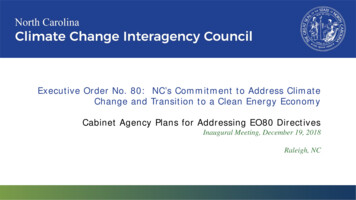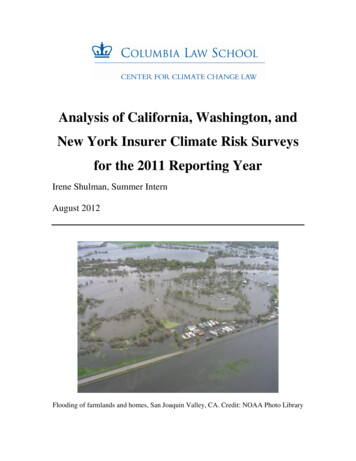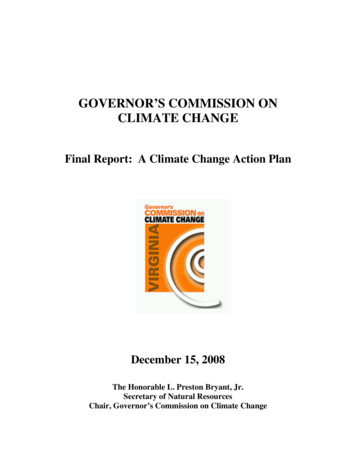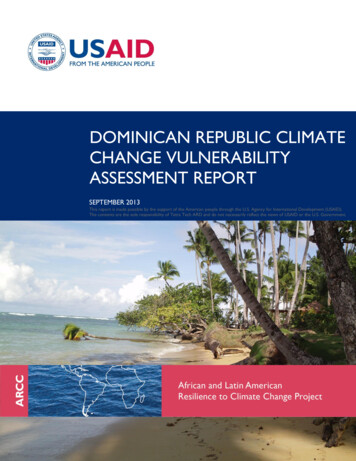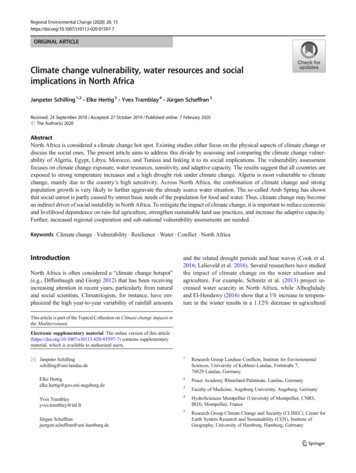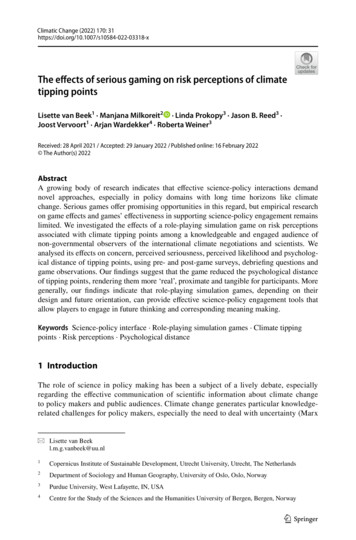
Transcription
CLIMATE CHANGE ACTION LISTWWW.MSTN.GOVT.NZ@MASTERTONDC
2
Masterton District Council (the Council) is taking up the challenge of climate change action in two ways. Firstly, we developed an internalCorporate Emissions Reduction plan in 2021 which sets out the ways our Council will reduce our climate pollution as an organisation. Andsecondly, we established a Community Focus Group to help us draft a Climate Action Plan for the Masterton District.Below is the list of proposed actions that have been developed by the Climate Change Community Focus Group in conjunction with the theCouncil.We now want feedback from the community on the proposed climate actions. More detail on how you can provide feedback is detailed in ourconsultation document and on the council website.In total, 118 proposed climate actions have been selected for community consultation, that are split across the nine theme areas. Each themealso has an overarching goal and sub-goals to indicate the direction and purpose of the proposed actions. We are asking to the community toprovide feedback on these goals.For each theme the proposed actions have been divided into the following three categories:A) Council leading/instigating/facilitating the actions to take place. Ideas or projects that are within Council’s remit to control (e.g. districtplan changes).B) Council advocating for action from central government, businesses, or industry. Asking for support from other entities that have thepower, funding, or mandate to help the Masterton District make changes, for example submitting on changes to central governmentpolicy or partnering with industry for local energy or transport projects.C) Council supporting other groups, organisations, or individuals to act. Providing advice, mentorship, funding, or connections tocommunity projects and people who are developing climate change initiatives in the District.Please note – each theme has a section at the beginning titled ‘work already in progress/planned’. This section outlines current or futurework the Council already intends to complete. The ideas listed in that section are not part of the consultation, but rather to give context as towhat is already in the Council work programme and why those ideas may be missing from the proposed actions list.1
The proposed actions are split into nine themes:1. COORDINATED REGIONAL APPROACH6. BUILT ENVIRONMENT- how we take a coordinated and strategic approachto climate change in the Greater Wellington Region.– how we design and retrofit for low-emissionconstruction and create infrastructure that isresilient to climate impacts.2. TRANSPORT– how our community moves around the Districtusing less climate-harming emissions.3. ENERGY/ELECTRICITY– how we power our homes and businesses throughrenewable energy.4. WATER– how we adapt to increasing severe floods, droughts,storms, and changes in precipitation rates.5. WASTE & CIRCULAR ECONOMY– how we reduce our consumption and repurposeold items.27. NATURAL ENVIRONMENT– how we protect our native biodiversity throughclimate solutions.8. AGRICULTURE & FORESTRY– how we promote and support a low-emissiontransition in the rural sector by removing localbarriers to action.9. COMMUNITY EMPOWERMENT– how we ensure our plan does not increasecurrent inequities in our district but helps build amore resilient and fair community.
1. COORDINATED REGIONAL APPROACHHow we take a coordinated and strategic approach to tackling climate change in the Greater Wellington Region.GoalConnected regional approach to mitigating and adapting to climate change which allows for knowledge sharing and usesCouncil resources/staff capacity wisely.Sub-goalUtilise the current and future regional projects to feed into council decision making around climate change mitigationand adaptation.WORK ALREADY IN PROGRESS/PLANNEDActionCouncil to participate in the development of a regional climate change impact assessment (2022).Council to participate in the development of a regional emissions reduction strategy (2022).PROPOSED NEW ACTIONSCOUNCIL TO SUPPORT OTHERSNumberActionCouncil role and potentialpartners/collaborators1.Council to develop a coordinated climate action implementation approach with ManaWhenua, other Wairarapa district councils and Greater Wellington Regional Council.2.Council to participate in the development of a regional climate change adaptation strategy.Council to support GreaterWellington Regional Council andlocal councils in the region.3
2. TRANSPORTHow our community moves around the District using less climate-harming emissions.Goal Increase uptake of low-emission, active and public transport options in the Masterton District.Sub-goals y Masterton District Council reduces its own organisational carbon footprint from transport.y Masterton District Council supports the community to transition to low-emission transport.y Improve the public transport network (buses, shuttles, and trains) to get people out of cars as much as possible in a rural area.y Masterton District has well designed streets and roads that minimise transport emissions.y Improved active transport networks (footpaths, cycleways, and walking tracks) to encourage alternatives modes of transport.WORK ALREADY IN PROGRESS/PLANNEDActionCouncil moves to a mostly EV work fleet by 2025 (excluding current diesel fleet vehicles that won’t be able to be convertedunder current technology).Council to adopt a fully electric corporate vehicle fleet by 2030 (provided mature technology is available).Council to investigate and evaluate options for off-road and high-performance electric vehicles.Council to incorporate E-bikes into the fleet.Where Air Travel is needed by Council staff, the Council off-sets carbon associated with these flights.Council to advocate for increased rail capacity for freight and commuter trains in/out of the Wairarapa.Council to develop the Five Town Trails Network (cycling) to allow for commuter and school student active transport.4
PROPOSED NEW ACTIONSCOUNCIL TO LEADNumberActionCouncil role and potentialpartners/collaborators3.Council to create active transport networks/cycleways to encourage alternativesmodes of transport. Create cycle lanes or shared road/footpaths prioritising areasthat connect to schools and recreation spaces, including a cycle network connectingKuripuni/South, Town Centre, Masterton East, Masterton West, and Lansdowne. Thenetwork should connect in with the Wairarapa region’s Five Town Trail Network cyclinginfrastructure project.Council to lead local projects, andadvocate to Waka Kotahi for StateHighway sections.4.Council to facilitate the installation of more publicly available EV infrastructurethroughout the District including both urban and rural areas, including:Council to facilitate, and advocateto Greater Wellington RegionalCouncil, Destination Wairarapa,central government and businesssector for support and funding.y promotion of the current EV charging stations to the community morey installing EV charging stations in urban Mastertony installing EV charging stations in rural hubs such as schools and coastal settlements.5.Subsidise bikes for Community Services Card holders.Council to lead, and to advocate tocentral government and businesssector for funding.6.Commission study of current and potential public transport users in partnership withGreater Wellington Regional Council to understand:Council to lead in partnershipwith Greater WellingtonRegional Council.y current and future needs of usersy constraints/barriers for community to use public transporty potential incentives.5
7.Support pilot initiative(s) to test outcomes of public transport study.Council to lead in partnershipwith Greater WellingtonRegional Council.8.Reduce speed limits on Masterton District Council-managed rural roads to mitigatecarbon emissions and improve access for cyclists and pedestrians.Council to lead.9.Improve throughflow in urban Masterton to reduce traffic congestion at peak times,which will reduce emissions as idling traffic is a significant source of climate pollution.Council to lead local projects, andpartner with Waka Kotahi for SH2and bypass.10.Determine the District’s transport emissions and monitor changes over time toestablish effectiveness of the Climate Action Plan. Customise Greater WellingtonRegional Council carbon emissions inventory for the District.Council to lead in partnershipwith Greater WellingtonRegional Council.11.Council to require all council contractors to use low carbon vehicles or offset theirtransport emissions.Council to lead.COUNCIL TO ADVOCATE6NumberActionCouncil role and potentialpartners/collaborators12.Council to advocate for the creation of safe cycle lane between main centres inWairarapa along SH2 (for both commuters and recreation). The connected cyclewaywould be part of the Five Towns Trails Network but with a higher emphasis oncommuter and local community recreation, rather than tourism.Council to advocate to WakaKotahi and Greater WellingtonRegional Council.
COUNCIL TO SUPPORT OTHERSNumberActionCouncil role and potentialpartners/collaborators13.Council to support a provider to hire out a pool of bikes to school students each year.Council to support local provider,and bid for central governmentand business sector funding14.Council to encourage uptake of lower or no emissions vehicles, e.g. working withadvertisers and dealerships to promote EVs, hybrids and low-emission vehicles.Council to supportlocal businesses.15.Council to support local businesses to opt for lower transport emissions. For example,businesses which transition to an EV fleet and use solar for vehicle energy charging aregiven rates rebates.Council to supportlocal businesses.7
3. ENERGY/ELECTRICITYHow we power our homes and businesses through renewable energy.Goal Masterton District has transitioned to zero-emissions energy sources.Sub-goals y Masterton District Council follows energy efficient practicesy Masterton District Council promotes ways for community members and businesses to be more energy efficient (includingcommunity education).WORK ALREADY IN PROGRESS/PLANNEDActionKey project: Masterton District Council to conduct an energy audit of council facilities.Masterton District Council to reduce organisational energy waste as set out in Corporate Emissions Reduction Strategy.8
PROPOSED NEW ACTIONSCOUNCIL TO LEADNumberActionCouncil role and potentialpartners/collaborators16.Council to determine the District’s current energy use and monitor changes to establishthe effectiveness of the Climate Action Plan.Council to lead.17.Council to develop a programme of information on energy efficiency for the communityto easily access.Council to lead, and advocate tocentral government and businesssector for funding.18.Council to support wider conversion to LED lighting across the District.Council to lead.19.Council to install solar and/or wind generation infrastructure on appropriate MDCbuildings and ensure all Masterton District Council buildings are well insulated.Council to lead.20.Council to investigate the potential for greater utilisation of roof areas for solar powergeneration. Showcase opportunities through pilots on public assets. Address currentbarriers to uptake and investigate incentives.Council to lead.Research:y the best options for different locations and building typesy how these could benefit energy generation in the Wairarapay where the most gains are in terms of energy generation.9
COUNCIL TO SUPPORT OTHERS10NumberActionCouncil role and potentialpartners/collaborators21.Council to support residents to convert to energy efficient products.Council to support, and advocateto central government andbusiness sector for funding.22.Council to support businesses to convert to renewable energy and efficient lighting andheating products.Council to support, and advocateto central government andbusiness sector for funding.23.Council to promote alternative energy development in the District and support ruraldevelopment of alternative energy production, e.g. micro-hydro, wind, solar, biomass.Council to support, and advocateto central government andbusiness sector for funding.
4. WATERHow we adapt to increasingly severe floods, droughts, storms, and changes in precipitation rates.GoalMasterton District has biologically healthy rivers which provide for our local communities, and our flora and fauna.Sub-goals y Masterton has access to enough water to service a growing population.y Masterton is prepared for increasingly severe water hazards/risk (floods, droughts, storm events).y Masterton District Council has a clear picture of the health of the district’s rivers, including what parts are improving andwhat parts need urgent attention.y Our community has a clear understanding of the health of our district’s rivers and know what work is being done toimprove them.WORK ALREADY IN PROGRESS/PLANNEDActionMasterton District Council undertakes emissions reduction work on wastewater and wastewater treatment process as set outin the Corporate Emissions Reduction Strategy.11
PROPOSED NEW ACTIONSCOUNCIL TO LEAD12NumberActionCouncil role and potentialpartners/collaborators24.Council to identify council assets that are within projected flooding and sea level risechanges over the next 100 years. Utilise NIWA climate change projections and regionalclimate change risk assessment to understand specific infrastructure vulnerabilitiesto river and lowland flooding and coastal storm surge and sea-level rise, includingchanges in erosion / deposition.Council to lead in collaborationwith regional climate changeimpact assessment work.25.Council to map climate impacts (sea level rise/coastal erosion, flooding, fire risk etc)across the three district areas – coastal, rural, and urban.Council to lead in collaborationwith regional climate changeimpact assessment work.26.Council to determine approach to risk mitigation (such as adaptive design and planningpathways as recommended by the Ministry for the Environment). Use those changesin risk to educate the community on what the council needs to do next to mitigate theissues.Council to lead.27.Council to undertake measures to mitigate the effects of flooding and sea-level rise.Council to lead in collaborationwith Greater WellingtonRegional Council.28.Council to ensure Masterton District has a reliable and safe water supply.Council to lead in collaborationwith regional water entities,and collaborate and supportduring sub-regional and regionalstrategic planning processes.
29.Council to ensure climate projections are used in planning for water resourcesinfrastructure (dams, rivers, groundwater, pipelines, water races).Council to lead in collaborationwith Greater WellingtonRegional Council.30.Council to incentivise residents to install rainwater tanks (non-potable).Council to lead.31.Council to update internal extreme weather response to make it fit for purpose withnew climate change impacts.Council to lead in collaborationwith the Wellington RegionEmergency Management Office(WREMO).32.Council to be well-prepared to support communities in the event of extreme weatherevents, such as flooding and fire events. Examples could include sandbags, floodbarriers, water testing kits, evacuation plans, etc.Council to lead in collaborationwith the Wellington RegionEmergency Management Office(WREMO).33.Council to ensure new stormwater infrastructure is designed for increasing frequencyof extreme weather events.Council to lead in collaborationwith regional climate changeimpact assessment work.34.Council to investigate the potential for greater utilisation of roof areas for watercapture. Showcase opportunities through pilots on public assets. Address currentbarriers to uptake and investigate incentives.Council to lead.Research:y what are the best options for different locations and building typey how they could benefit stormwater management, rainwater harvesting and foodgrowing in the Wairarapa.35.Council to identify options for reducing risk from flooding, including riparian planting,stop banks, wetlands, restrictions on building. Also in ‘Natural Environment’ section.Council to lead in collaborationwith Greater WellingtonRegional Council.13
COUNCIL TO ADVOCATENumberActionCouncil role and potentialpartners/collaborators36.Council to advocate to Greater Wellington Regional Council to monitor and modelclimate impacts on the water system to understand the resilience of the network.Council to advocate to GreaterWellington Regional Council.37.Council to advocate to Greater Wellington Regional Council for better water samplingdata sharing and use and increasing the data points collected if needed to get a clearpicture of the state of the District’s rivers. Also in ‘Natural Environment’ section.Council to advocate to GreaterWellington Regional Council.COUNCIL TO SUPPORT OTHERS14NumberActionCouncil role and potentialpartners/collaborators38.Council to support development of new water storage infrastructure or expansion ofexisting infrastructure, including the use of nature-based solutions.Council to support.39.Council to help identify options to reduce the frequency of toxic blooms in waterways.Also in ‘Natural Environment’ section.Council to support GreaterWellington Regional Council andMana Whenua.
5. WASTE & CIRCULAR ECONOMYHow we reduce our consumption and repurpose old items.GoalReduce Masterton District’s contribution to methane emissions from landfills.Sub-goals y Keep green waste and organic waste out of landfills to reduce methane emissions.y Masterton District Council is a role model and educator about reducing waste in the District.y Masterton District Council supports climate outcomes within local waste reduction initiatives.WORK ALREADY IN PROGRESS/PLANNEDActionMasterton District Council to reduce organisation office waste as directed in the Corporate Emissions Reduction Strategy.Encourage the adoption of innovation, green technology and circular solutions, and support suppliers as they transition to alower carbon economy.15
PROPOSED NEW ACTIONSCOUNCIL TO LEAD16NumberActionCouncil role and potentialpartners/collaborators40.Council to provide green waste mulching and composting service for thewider community.Council to lead.41Council to investigate the best way to deliver domestic organic waste collection inthe District.Council to lead.42Council to expand the current resource recovery operations in the District and build onthat infrastructure. Foster a culture around ‘repair not replace’ in the District. Councilto create ways to encourage our community to repair more and buy less. Council couldfacilitate training or repair café style events with the resource recovery groups andlocal businesses, promoting the idea of repairing broken or old household items vialocal community groups.Council to lead.43.Council to investigate specific actions for reducing our rural waste. Council to provideeducation and alternatives to reduce the amount of people in rural areas who burntheir household and farm waste, a practice that can contribute to carbon emissions.Council could provide alternatives for waste disposal in rural areas e.g. increasenon-compostable rubbish collection points further out from town or develop moreincentives for people to bring their non-organic waste to town. Council to encouragerural landowners / residents to compost their organic waste.Council to lead.
COUNCIL TO ADVOCATENumberActionCouncil role and potentialpartners/collaborators44.Council to lobby for centralised waste operation in Manawatū at Bonny Glen to recover morelandfill gas for power generation (this is where Masterton District sends all our waste).Council to advocate landfilloperator at Bonny Glen.45.Council to lobby central government to put a small levy on bailage wrap importers whichis then used to fund more effective recycling schemes to stop the plastic being burnt.Council to advocate tocentral government.COUNCIL TO SUPPORT OTHERSNumberActionCouncil role and potentialpartners/collaborators46.Council to promote home composting.Council to support/partner withcurrent or new community initiatives.47.Council to promote collection of organic waste from businesses for composting.Council to support/partner withcurrent or new community initiatives.48.Council to promote redistribution of surplus food from restaurants andsupermarkets, including supporting existing programmes such as Wai Waste.Council to support/partner withcurrent or new community initiatives.49.Council to reduce emissions linked to construction and demolition, includingcorporate full carbon accounting in all new builds and renovation (covered in moredetail in the Built Environment section).Council to supportconstruction industry.50.Council to partner with organisations that are educating the community on the linkbetween waste and climate change (including the connection between fossil fuelextraction and plastic, and localised food production and reduction in food ‘air androad miles’ (transport emissions).Council to support existing ornew organisations.17
6. BUILT ENVIRONMENTHow we design and retrofit for low-emission construction and create infrastructure that is resilient to climate impacts.GoalReduce carbon emissions related to creating and maintaining infrastructure (including buildings) and ensure infrastructure isdesigned to withstand climate impacts.Sub-goals y Ensure the resilience of our district infrastructure from climate hazards (floods, droughts, heavy precipitation events,landslides, heat stress, wild fires). For example, prepare public areas, buildings and homes for extended heat waves.y Reduce emissions on council building projects.y Educate and support businesses and community on low-emission building.WORK ALREADY IN PROGRESS/PLANNEDActionDevelop and embed clear criteria and objectives around sustainability and carbon emissions reduction in all of our procurementprocesses including what is required from suppliers/contractors.Develop and embed requirements for carbon reduction in all business case and project management processes andframeworks.Embed the sustainability principles and incentivise sustainable technologies in the Wairarapa Combined District Plan (e.g.low carbon footprint buildings; energy efficiency; renewable energy use in buildings; enhanced green/sustainable urban/subdivision design, blue/green infrastructure).Investigate opportunities for partnership with local developers to showcase a green/sustainable village/subdivision.18
PROPOSED NEW ACTIONSCOUNCIL TO LEADNumberActionCouncil role and potentialpartners/collaborators51.Council to retrofit existing Masterton District Council buildings with energy-efficientair conditioners.Council to lead.52.Council to investigate opportunities for incorporating shade and covered walkways indesign of public spaces.Council to lead.53.Council to incorporate climate change considerations into Council procurementprocesses. Ensure Council’s tenders have a weighting for climate change.Council to lead.54.Council to use the development of the Youth Hub to investigate potential for lowemission infrastructure and renewable energy generation on Council assets. Ideascould include installing solar panels with interactive display to use as a teaching tooland installing water conservation equipment and a composting toilet.Council to lead.55.Council to utilise appropriate eco-design and low impact principles in all councilrefurbishment projects, including thorough utilisation of timber where feasible.Investigate low-emission and sustainable buildings practices for future councildevelopment.Council to lead.56.Council to investigate reduced building/compliance fees for proposed Green Star builds.Council to lead.57.Commit Council to low-emission building practices and day-to-day operations. Includeemissions reduction performance targets and outcomes in the design and constructionof infrastructure. Select and use third party green building and sustainable infrastructurerating tools to measure and reduce the environmental impact of our assets.Council to lead.19
58.Council to identify from national and international examples of lessons learned ondelivery of net zero energy buildings to inspire and enable easier and faster uptake oflow-emission buildings.Council to lead.59.Council to identify and remove barriers to low-emission design and construction, includingcouncil processes and enable other mechanisms such as incentivisation and upskilling.Council to lead, and support localbusinesses with the uptake.60.Council to investigate the potential for greater utilisation of roof areas for solar powergeneration. Showcase opportunities through pilots on public assets. Address currentbarriers to uptake and investigate incentives.Council to lead.Research:y what are the best options for distinct locations and building types,y how they could benefit biodiversity, energy generation, stormwater management,rainwater harvesting and food growing in the Wairarapa, andy where the most gains are in terms of energy generation.2061.Council to develop a deconstruction hub as part of the Resource Recovery Centre(covered in the Waste section) that provides infrastructure for industry to exchangekey materials and share best practice expertise. Embed circular economic principles toaddress construction and demolition waste.Council to lead.62.Council to embed climate change mitigation and adaptation measures into all councilcontrolled public spaces. Prioritise the use of low-carbon infrastructure in publicspaces e.g. e-charging infrastructure including e-bikes, scooters, wheelchairs, cars.Council to lead.63.Council to explore initiatives to reduce travel by adapting local venues for sporting andother events.Council to lead.64.Council to use underused land for opportunities such as energy generation andcarbon sequestration.Council to lead.
65.Council to explore the use of temporary assets to confirm community needs before anypermanent infrastructure is built.Council to lead.66.Council to assess climate change impacts for all new Council developments andinfrastructure. Council to develop a framework that will allow staff to consider climateimplications at each stage of project developmentCouncil to lead.67.Council to assess and support pathways to decrease construction of newinfrastructure in known climate hazard/risk zones.Council to lead in collaborationwith regional climate changeimpact assessment workalready underway.68.Council to adopt approaches to support decisions being made with reference topotential future climate impacts for new developments. One approach to considerwhich is supported by the Ministry for the Environment is the ‘dynamic adaptive policypathways’ approach. This approach aims for flexible and adaptable decision makingover time and has been used successfully by other councils for flooding and coastalerosion planning.Council to lead in collaborationwith regional climate changeimpact assessment work.69.Council to ensure new stormwater infrastructure is designed for increasing frequencyof extreme weather events. Also in ‘water’ section.Council to lead in collaborationwith regional climate changeimpact assessment work.70.Council to ensure clear climate hazard information is provided for developersand regulators.Council to lead in collaborationwith regional climate changeimpact assessment work.21
COUNCIL TO ADVOCATENumberActionCouncil role and potentialpartners/collaborators71.Council to lobby for legislative support. Council to advocate to central governmentto update the Building Code to consider waste and climate impacts for full lifecycleof buildings, including deconstruction, and when consents are lodged. Council toadvocate for central government to update the Building Code on a regular basis with allnew buildings required to operate at net zero carbon by 2030. For example, establishbinding agreements with central government to regularly review Building Code everytwo to three years.Council to advocate tocentral government.72.Council to encourage new builds to include effective climate control systems to allowfor internal temperatures that can support health during heat waves.Council to advocate.73.Council to use current and future research to determine whether emissions arereduced by repurposing construction waste or whether it is better to rebuild withsustainable materials.Council advocate to MBIE (Ministryof Business, Innovation andEmployment) for clear guidanceand to facilitate the localimplementation for this guidance.COUNCIL TO SUPPORT OTHERS22NumberActionCouncil role and potentialpartners/collaborators74.Council to promote and incentivise the certification of new domestic properties toperformance standards that meet the requirements of the Healthy Homes Act (e.g.,Passive House).Council to support local businessesand community members.
75.Council to support the delivery of a residential programme to reduce carbonemissions from the District’s commercial and residential buildings, including theinstallation of insulation, double glazing, efficient heating and lighting, and renewableenergy generation.Council to support localbusinesses.76.Council to partner with industry to develop a commercial building retrofit programmeto improve the efficiency and climate footprint of the District’s commercial buildings;promote and enable fuel switching to renewable sources.Council to support localbusinesses.77.Council to support businesses and residents to install energy efficient air conditioners(heat pumps).Council to support local businessesand community members.23
7. NATURAL ENVIRONMENTHow we protect our native biodiversity through climate solutions.GoalEnhance the capacity of the natural environment to sequester carbon and protect indigenous biodiversity from the impacts ofclimate change.Sub-goals y Masterton District Council supports legal protection of key biodiversity hotspot sites that will be importan
Council to lead, and advocate to central government and business sector for funding. 18. Council to support wider conversion to LED lighting across the District. Council to lead. 19. Council to install solar and/or wind generation infrastructure on appropriate MDC buildings and ensure all Masterton District Council buildings are well insulated.

